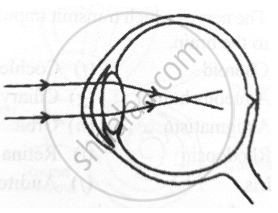Advertisements
Advertisements
प्रश्न
State the Function:
Visual purple
उत्तर
It has vitamin A derivative that helps the eyes to see in dim light.
APPEARS IN
संबंधित प्रश्न
The human eye can focus objects at different distances by adjusting the focal length of the eye lens. This is due to ______.
Myopia is an example of ______.
What job does the pupil of the eye do?
What do the ciliary muscles do when you are focusing on a nearby object?
To focus the image of a nearby object on the retina of an eye:
(a) the distance between eye-lens and retina is increased
(b) the distance between eye-lens and retina is decreased
(c) the thickness of eye-lens is decreased
(d) the thickness of eye-lens is increased
After testing the eyes of a child, the optician has prescribed the following lenses for his spectacles:
Left eye : + 2.00 D
Right eye : + 2.25 D
The child is suffering from the defect of vision called:
(a) short-sightedness
(b) long-sightedness
(c) cataract
(d) presbyopia
Name two animals having eyes:
one the sides of the head.
Among animals, the predators (like lions) have their eyes facing forward at the front of their heads, whereas the animals of prey (like rabbit) usually have eyes at the sides of their head. Why is this so?
Define the following:
Yellow spot
Give the main function of the following:
Three semicircular canals
Write whether the following is true or false:
Rods are the receptor cells in the retina of the eye sensitive to dimlight.
State the Location:
Iris
State the Function:
Choroid coat in the eye
Write the function of the human eye and label parts of the figure given below.

______ is tough and thick white sheath that protects the inner parts of the eye.
When light rays enter the eye, most of the refraction occurs at the ____________.
Given below is a diagram depicting a defect of the human eye. Answer the questions that follow:

- Give the scientific term for the defect.
- Mention one possible reason for the defect.
- What type of lens can be used to correct the defect?
Eyes of the nocturnal birds have large cornea and a large pupil. How does this structure help them?
The layer in the eye where sensory cells (rods and cones) are located ______.
An aperture that controls the passage of light into the eye is ______.
